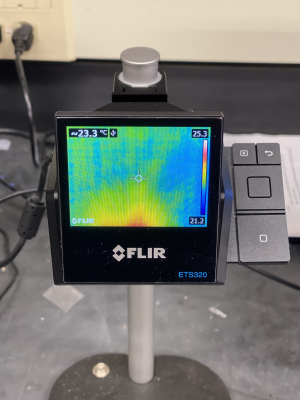Infrared Camera
| FLIR ETS320 Infrared Camera [SOP] |
|---|
| Max Temperature: 250[math]\displaystyle{ ^\circ }[/math]C |
| Accuracy: [math]\displaystyle{ \pm }[/math]3[math]\displaystyle{ ^\circ }[/math]C |
Infrared Cameras are used for thermal imaging and display the surface temperature of object in a heat map. The primary use of the FLIR Infrared Camera is for imaging heat transfer in electronic components.
For more about infrared light and the electromagnetic spectrum, see Electromagnetic Spectrum.
Principle
Thermal imaging cameras have lenses, just like visible light cameras [1] . However, these specialized lenses on focuses infrared light emitted by all of the objects in view. The focused light is scanned by a phased array of infrared-detector elements. The detector elements create a very detailed temperature pattern called a thermogram. It only takes about one-thirtieth of a second for the detector array to obtain the temperature information to make the thermogram. This information is obtained from several thousand points in the field of view of the detector array.
The thermogram created by the detector elements is translated into electric impulses. The impulses are sent to a signal-processing unit, a circuit board with a dedicated chip that translates the information from the elements into data for the display. The signal-processing unit sends the information to the display, where it appears as various colors depending on the intensity of the infrared emission. The combination of all the impulses from all of the elements creates the image.
Heat sensed by an infrared camera can be very precisely quantified, or measured, allowing one to not only monitor thermal performance, but also identify and evaluate the relative severity of heat-related problems.
References
- ↑ Elevology. (n.d.). Beginners Guide to Infrared Camera Technology. Ajax Environmental & Safety Supply, Inc. https://www.thermalcamerarentals.com/resource-center/beginners-guide-to-infrared-camera-technology.
